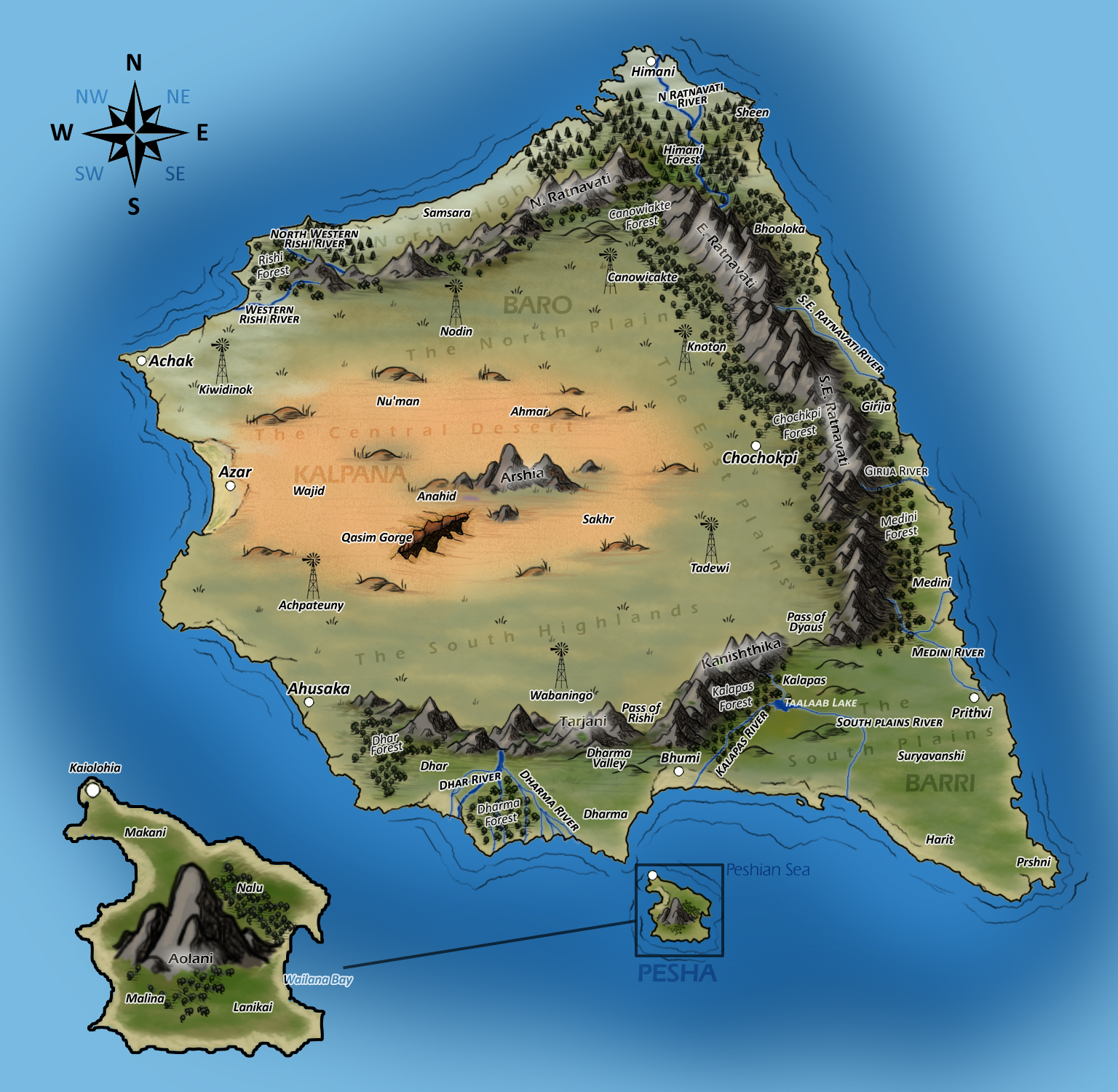The Drabardi Island
Weather and Climate
 The island has a wide variety of biogeographic regions, ranging from at times snow-capped mountaintops to large arid deserts and temperate forests. The terrain is however for the most part low plateau with deserts, rangelands and a more fertile plain in the south in the Barri territory.
For the farmers that have big herds of cattle and sheep the Baro territory is perfect, with wide open spaces. There is a need however to help the cattle to get access to water, so several 'watermills' and shallow pools have been put up. This is something the donkeys use despite that some of the cowboys (most often working for Mr Manatee) wont hesitate to shot them - as they are seen as pests that take grazing and water from the herds.
The Kalpana territory has a desert climate, with arid to semi-arid conditions. Inland, summers can be scorching hot, while in winter nights can drop well below freezing. The small island of Pasha, in the south, have a similar climate as Barri, but often much warmer having more tropical type of forest.
The island has a wide variety of biogeographic regions, ranging from at times snow-capped mountaintops to large arid deserts and temperate forests. The terrain is however for the most part low plateau with deserts, rangelands and a more fertile plain in the south in the Barri territory.
For the farmers that have big herds of cattle and sheep the Baro territory is perfect, with wide open spaces. There is a need however to help the cattle to get access to water, so several 'watermills' and shallow pools have been put up. This is something the donkeys use despite that some of the cowboys (most often working for Mr Manatee) wont hesitate to shot them - as they are seen as pests that take grazing and water from the herds.
The Kalpana territory has a desert climate, with arid to semi-arid conditions. Inland, summers can be scorching hot, while in winter nights can drop well below freezing. The small island of Pasha, in the south, have a similar climate as Barri, but often much warmer having more tropical type of forest.
Seasons on Drabardi Island
On the timeline page you will find a rough "sketch" on the seasons on the island, there are really just two - rainy and dry season - it rain most in spring and summer and its the driest in winter. Its in winter most sicknesses come around. Those donkeys that have a healing blessing (magic) can never 100% cure someone, but they can prevent someone from dying. They cant bring someone back from the dead.
Flora and Fauna
There are a few forests on the island and they are scattered to the outer edges and close to the mountains where there are more moist and fertile grounds. Types range from temperate broadleaf and mixed forest (north/northeast) to temperate rainforest (southwest, mainly on Pesha). Major predators Drabardi ulvs and Ratnavati Catamounts (a type of mountain lions), and to a lesser extent the Drabardi bear (a type of small marsupial bear but still a fierce predator, that mainly live in the north and northeast) are the biggest predators and threat to the donkey herds.
Humans & Your donkey
How your donkey views humans is up to you. Its perfectly fine if you want to have your wild donkey interact some with humans, but it should be through your donkeys pov. Remember - there are NO horses on the Drabardi Island and once your donkey leave the island it can never come back.
Humans & Tame Drabardis
Tamed Barri's (living ON the island) are mostly used on the farms even if the larger farms do have tractors, a surefooted donkey have many times proved to be a better choice than a vehicle. Not many of the Barri's are living a fully 'wild life'. Some island breeders do let their breedingstock roam semi-wild in the belief they become stronger and more hardy that way. There is a small landing strip for airplanes but most of the heavier traffic to the island are done by boat. This is also how the Drabardi is exported from the island. Tamed Baro's and Kalpana's are used for riding and lighter pulling, and the Pesha's for children, pulling small carts (for grown humans) or as companions. The three later types are the most common types to be exported off the island. For tame Drabardis (all types) in the HARPG world you would play the donkey as you would a 'regular' horse. If the donkey is born on the island it might have some natural 'backstory' if you so wish.
Humans & Wild Drabardis
It's up to you how your wild donkey see humans, how much interaction (of any kind, good or bad) you want but the humans do exist and might be at least some minor interaction, even if it might only be at a distance. The donkeys CAN'T speak to in 'human talk', but the donkeys with a telepathic gift may have the ability to communicate in this way with humans if they want to. It wont be 'on a clear line' so to speak, and it will be hard for the donkey to understand everything. At times the humans go out to capture wild Drabardis (young and old, even if they seem to aim for young ones since they are easier to corral), either to sell to the mainland or to break into new working animals. There are also times when the wild herds are hunted for their skin and meat, especially when a herd are said to repeatedly 'causing trouble' according to the humans. Some underground markets have gotten the news on the breeds special abilities and there have been ilegal hunting reported.
UP